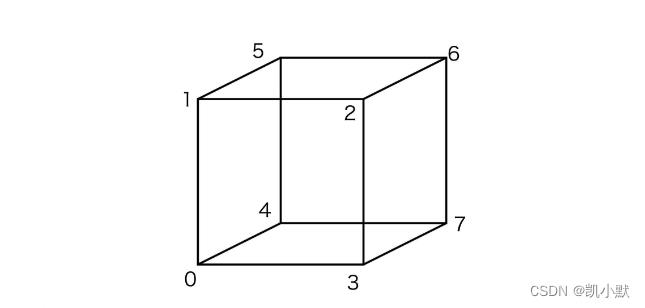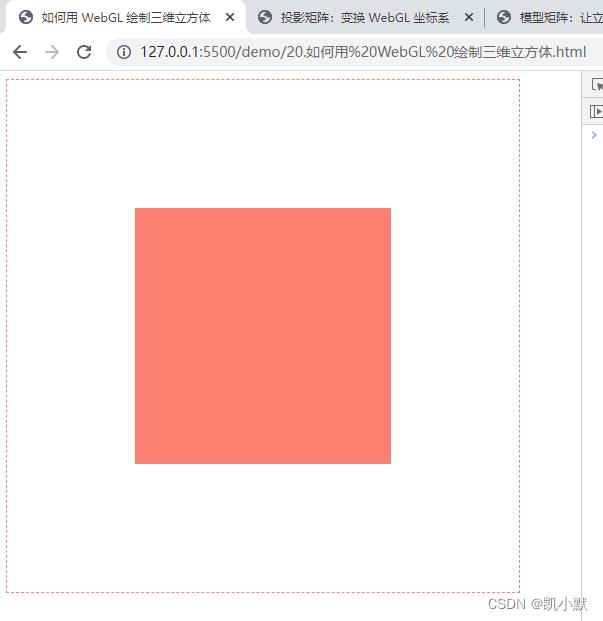视觉高级篇20 # 如何用WebGL绘制3D物体?
Posted 凯小默
tags:
篇首语:本文由小常识网(cha138.com)小编为大家整理,主要介绍了视觉高级篇20 # 如何用WebGL绘制3D物体?相关的知识,希望对你有一定的参考价值。
说明
【跟月影学可视化】学习笔记。
如何用 WebGL 绘制三维立方体
我们知道立方体有8个顶点,6个面,在 WebGL 中,需要用 12 个三角形来绘制它。把每个面的顶点分开,需要 24 个顶点。

绘制 3D 图形与绘制 2D 图形有一点不一样,必须要开启深度检测和启用深度缓冲区。
在 WebGL 中,可以通过 gl.enable(gl.DEPTH_TEST),来开启深度检测。
在清空画布的时候,也要用 gl.clear(gl.COLOR_BUFFER_BIT | gl.DEPTH_BUFFER_BIT),来同时清空颜色缓冲区和深度缓冲区。
<!DOCTYPE html>
<html lang="en">
<head>
<meta charset="UTF-8" />
<meta http-equiv="X-UA-Compatible" content="IE=edge" />
<meta name="viewport" content="width=device-width, initial-scale=1.0" />
<title>如何用 WebGL 绘制三维立方体</title>
<style>
canvas
border: 1px dashed salmon;
</style>
</head>
<body>
<canvas width="512" height="512"></canvas>
<script src="./common/lib/gl-renderer.js"></script>
<script type="module">
const vertex = `
attribute vec3 a_vertexPosition;
attribute vec4 color;
varying vec4 vColor;
void main()
gl_PointSize = 1.0;
vColor = color;
gl_Position = vec4(a_vertexPosition, 1);
`;
const fragment = `
#ifdef GL_ES
precision highp float;
#endif
varying vec4 vColor;
void main()
gl_FragColor = vColor;
`;
const canvas = document.querySelector("canvas");
// 开启深度检测
const renderer = new GlRenderer(canvas,
depth: true
);
const program = renderer.compileSync(fragment, vertex);
renderer.useProgram(program);
// 用来生成立方体 6 个面的 24 个顶点,以及 12 个三角形的索引
function cube(size = 1.0, colors = [[1, 0, 0, 1]])
const h = 0.5 * size;
// 立方体的顶点
const vertices = [
[-h, -h, -h],
[-h, h, -h],
[h, h, -h],
[h, -h, -h],
[-h, -h, h],
[-h, h, h],
[h, h, h],
[h, -h, h],
];
const positions = [];
const color = [];
const cells = [];
let colorIdx = 0;
let cellsIdx = 0;
const colorLen = colors.length;
function quad(a, b, c, d)
[a, b, c, d].forEach((i) =>
positions.push(vertices[i]);
color.push(colors[colorIdx % colorLen]);
);
cells.push(
[0, 1, 2].map(i => i + cellsIdx),
[0, 2, 3].map(i => i + cellsIdx),
);
colorIdx++;
cellsIdx += 4;
// 立方体的六个面
quad(1, 0, 3, 2);
quad(4, 5, 6, 7);
quad(2, 3, 7, 6);
quad(5, 4, 0, 1);
quad(3, 0, 4, 7);
quad(6, 5, 1, 2);
return positions, color, cells ;
const geometry = cube(1.0, [
[250/255, 128/255, 114/255, 1], // salmon rgb(250 128 114)
[218/255, 165/255, 32/255, 1],// goldenrod rgb(218, 165, 32)
[46/255, 139/255, 87/255, 1], // seagreen rgb(46 139 87)
[255/255, 192/255, 203/255, 1], // pink rgb(255, 192, 203)
[135/255, 206/255, 235/255, 1],// skyblue rgb(135, 206, 235)
[106/255, 90/255, 205/255, 1], // slateblue rgb(106, 90, 205)
]);
renderer.setMeshData([
positions: geometry.positions,
attributes:
color: geometry.color,
,
cells: geometry.cells,
,
]);
renderer.render();
</script>
</body>
</html>

投影矩阵:变换 WebGL 坐标系
上面朝向我们的面应该是 goldenrod 颜色, WebGL 默认的剪裁坐标的 z 轴方向,的确是朝内的。WebGL 坐标系就是一个左手系而不是右手系。下面我们需要将 WebGL 的坐标系从左手系转换为右手系。
实际上就是将 z 轴坐标方向反转,对应的齐次矩阵如下:
[
1, 0, 0, 0,
0, 1, 0, 0,
0, 0, -1, 0,
0, 0, 0, 1
]
<!DOCTYPE html>
<html lang="en">
<head>
<meta charset="UTF-8" />
<meta http-equiv="X-UA-Compatible" content="IE=edge" />
<meta name="viewport" content="width=device-width, initial-scale=1.0" />
<title>投影矩阵:变换 WebGL 坐标系</title>
<style>
canvas
border: 1px dashed rgb(250, 128, 114);
</style>
</head>
<body>
<canvas width="512" height="512"></canvas>
<script src="./common/lib/gl-renderer.js"></script>
<script type="module">
const vertex = `
attribute vec3 a_vertexPosition;
attribute vec4 color;
varying vec4 vColor;
uniform mat4 projectionMatrix;
void main()
gl_PointSize = 1.0;
vColor = color;
gl_Position = projectionMatrix * vec4(a_vertexPosition, 1);
`;
const fragment = `
#ifdef GL_ES
precision highp float;
#endif
varying vec4 vColor;
void main()
gl_FragColor = vColor;
`;
const canvas = document.querySelector("canvas");
// 开启深度检测
const renderer = new GlRenderer(canvas,
depth: true
);
const program = renderer.compileSync(fragment, vertex);
renderer.useProgram(program);
// 用来生成立方体 6 个面的 24 个顶点,以及 12 个三角形的索引
function cube(size = 1.0, colors = [[1, 0, 0, 1]])
const h = 0.5 * size;
// 立方体的顶点
const vertices = [
[-h, -h, -h],
[-h, h, -h],
[h, h, -h],
[h, -h, -h],
[-h, -h, h],
[-h, h, h],
[h, h, h],
[h, -h, h],
];
const positions = [];
const color = [];
const cells = [];
let colorIdx = 0;
let cellsIdx = 0;
const colorLen = colors.length;
function quad(a, b, c, d)
[a, b, c, d].forEach((i) =>
positions.push(vertices[i]);
color.push(colors[colorIdx % colorLen]);
);
cells.push(
[0, 1, 2].map(i => i + cellsIdx),
[0, 2, 3].map(i => i + cellsIdx),
);
colorIdx++;
cellsIdx += 4;
// 立方体的六个面
quad(1, 0, 3, 2);
quad(4, 5, 6, 7);
quad(2, 3, 7, 6);
quad(5, 4, 0, 1);
quad(3, 0, 4, 7);
quad(6, 5, 1, 2);
return positions, color, cells ;
const geometry = cube(1.0, [
[250/255, 128/255, 114/255, 1], // salmon rgb(250 128 114)
[218/255, 165/255, 32/255, 1],// goldenrod rgb(218, 165, 32)
[46/255, 139/255, 87/255, 1], // seagreen rgb(46 139 87)
[255/255, 192/255, 203/255, 1], // pink rgb(255, 192, 203)
[135/255, 206/255, 235/255, 1],// skyblue rgb(135, 206, 235)
[106/255, 90/255, 205/255, 1], // slateblue rgb(106, 90, 205)
]);
// 将 z 轴坐标方向反转,对应的齐次矩阵如下,转换坐标的齐次矩阵,又被称为投影矩阵(ProjectionMatrix)
renderer.uniforms.projectionMatrix = [
1, 0, 0, 0,
0, 1, 0, 0,
0, 0, -1, 0,
0, 0, 0, 1,
];
renderer.setMeshData([
positions: geometry.positions,
attributes:
color: geometry.color,
,
cells: geometry.cells,
,
]);
renderer.render();
</script>
</body>
</html>

模型矩阵:让立方体旋转起来
用立方体沿 x、y、z 轴的旋转来生成模型矩阵。以 x、y、z 三个方向的旋转得到三个齐次矩阵,然后将它们相乘,就能得到最终的模型矩阵。
<!DOCTYPE html>
<html lang="en">
<head>
<meta charset="UTF-8" />
<meta http-equiv="X-UA-Compatible" content="IE=edge" />
<meta name="viewport" content="width=device-width, initial-scale=1.0" />
<title>模型矩阵:让立方体旋转起来</title>
<style>
canvas
border: 1px dashed rgb(250, 128, 114);
</style>
</head>
<body>
<canvas width="512" height="512"></canvas>
<script src="./common/lib/gl-renderer.js"></script>
<script type="module">
import multiply from 视觉高级篇22 # 如何用仿射变换来移动和旋转3D物体?
视觉高级篇21 # 如何添加相机,用透视原理对物体进行投影?